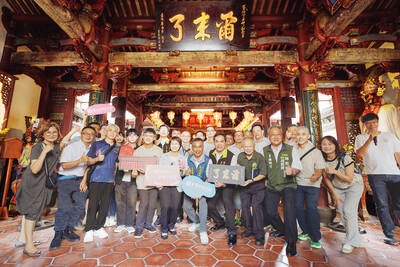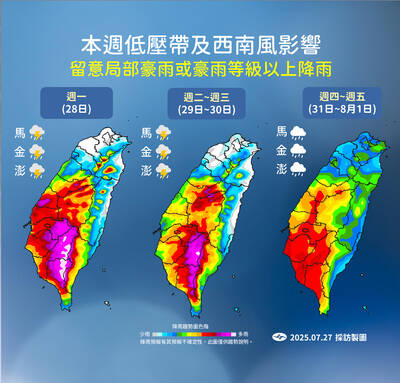Software engineer Ma Wan-chun (馬萬鈞) and a team based at the University of Southern California (USC) were acknowledged by the Academy of Motion Picture Arts and Sciences for their face-digitizing technology, which has been advancing visual effects for a decade.
Ma, who now works as an engineer for Google, on Feb. 9 was awarded the Scientific and Technical Achievement Award along with his colleagues at the 91st Academy Awards for their computer graphics technology developed at the university’s Institute for Creative Technologies.
Their polarized spherical gradient illumination technology is a facial appearance capture method that uses a dome-shaped object called “Light Stage X,” Google said.
When an actor performs inside Light Stage X, they are illuminated by about 300 LEDs and their gestures are captured by cameras from different angles.
The footage is converted into a 3D model that is then used for visual effects, enabling the computer to understand the geometry, pore texture and light properties of the actor’s face, Google said.
Ma said that the technology, which can generate lifelike facial expressions, has transformed the movie industry.
For example, it created an older version of Brad Pitt in The Curious Case of Benjamin Button (2008), brought the Na’vi tribe to the screen in Avatar (2009) and recreated Paul Walker’s performance in Furious 7 (2015) after the actor passed away mid-production.
Ma said that he has always been fascinated by visual effects in movies and video games, such as the diverse alien characters in the Star Wars movie series and the combination of real actors and animated backgrounds in the 1994 game Wing Commander 3.
As the field of computer graphics is still in its infancy in Taiwan, the Graduate Student Study Abroad Program of the National Science Council helped him pursue his studies, Ma said.
Under the program, he went to USC, where his faculty adviser, Paul Debevec, brought Ma into his research team in 2005 to help develop the facial capture system.
Ma said that instead of only researching for his doctoral dissertation, he always wanted to put his expertise into practice, and the work at USC helped him “turn imagination into reality.”
The team’s next step is to transfer the realistic visual effects presented in theaters to smartphones by applying the technology to the fields of augmented reality and virtual reality, Ma said.

The Central Weather Administration (CWA) today issued a "tsunami watch" alert after a magnitude 8.7 earthquake struck off the Kamchatka Peninsula in northeastern Russia earlier in the morning. The quake struck off the east coast of the Kamchatka Peninsula at 7:25am (Taiwan time) at a depth of about 19km, the CWA said, citing figures from the Pacific Tsunami Warning Center. The CWA's Seismological Center said preliminary assessments indicate that a tsunami could reach Taiwan's coastal areas by 1:18pm today. The CWA urged residents along the coast to stay alert and take necessary precautions as waves as high as 1m could hit the southeastern

The National Museum of Taiwan Literature is next month to hold an exhibition in Osaka, Japan, showcasing the rich and unique history of Taiwanese folklore and literature. The exhibition, which is to run from Aug. 10 to Aug. 20 at the city’s Central Public Hall, is part of the “We Taiwan” at Expo 2025 series, highlighting Taiwan’s cultural ties with the international community, National Museum of Taiwan Literature director Chen Ying-fang (陳瑩芳) said. Folklore and literature, among Taiwan’s richest cultural heritages, naturally deserve a central place in the global dialogue, Chen said. Taiwan’s folklore would be immediately apparent at the entrance of the

Speeding and badly maintained roads were the main causes of a school bus accident on a rainy day in Taipei last year that severely injured two people and left 22 with minor injuries, the Taiwan Transportation and Safety Board said. On March 11 last year, a Kang Chiao International School bus overturned inside the Wenshan Tunnel (文山隧道) on the northbound lane of the Xinyi Expressway. The tour bus, owned by Long Lai Co, exceeded the speed limit after entering the tunnel, the board’s investigation found. Sensing that the rear of the vehicle was swaying, the driver attempted to use the service and exhaust

Central and southern Taiwan are to see increasingly heavy rainfall from last night through Friday due to the effects of a low-pressure system and southwesterly winds, the Central Weather Administration (CWA) said. CWA forecaster Liu Pei-teng (劉沛滕) said Tropical Storm Co-May had weakened into a low-pressure system on Saturday, but that it strengthened again into a tropical depression (TD 11) near the seas around Japan's Ryukyu Islands due to favorable environmental conditions. The tropical depression is expected to persist for two to three days, moving west-northwest by this afternoon and reaching China's Zhejiang through the East China Sea tomorrow,